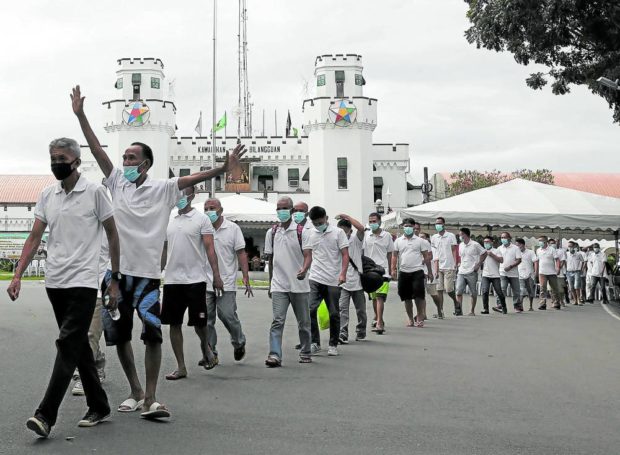DOJ seeks clemency for 2,000 prisoners to ease Bilibid congestion

ROAD TO FREEDOM More than 300 inmates from different prisons and penal farms of the Bureau of Corrections will spend Christmas with their families following their release after a program at New Bilibid Prison in Muntinlupa City on Monday, Dec. 19, 2022. (Photo by RICHARD A. REYES / Philippine Daily Inquirer)
MANILA, Philippines — The Department of Justice (DOJ) is seeking executive clemency for around 2,000 inmates at the New Bilibid Prison (NBP) in line with plans to decongest the “mega prison” in Muntinlupa City.
“(Through) clemency, we aim to release around 2,000 (prisoners) from here probably within 60 to 75 days,” Justice Secretary Jesus Crispin Remulla told reporters at NBP on Monday after he oversaw the release of 328 prisoners under the Bureau of Corrections (BuCor).
He said the process was ongoing with the submission of names starting way back in September. “I will see Executive Secretary (Lucas Bersamin) tomorrow (Dec. 20) and we will probably arrive at a more definite date in the next few days for the (grant of) clemency.”
According to Remulla, BuCor will target the release of some 700 to 800 eligible prisoners monthly. He has prioritized the NBP’s decongestion, blaming extreme overcrowding for inhumane living conditions and unchecked criminal activities, including drug trafficking.
“We want [the transfer of prisoners out of NBP] completed by 2027. We hope the regional prisons will be completed so we can close down this mega prison which is a monstrosity,” he said.
Article continues after this advertisementAs of October, NBP has 29,204 inmates while its capacity is only 6,435, resulting in a congestion rate of 354 percent, based on BuCor data.
Article continues after this advertisementPresidential power
The president has the power to grant executive clemency in the form of absolute pardon, conditional pardon with or without parole, or commutation or reduction of sentence.
The law sets minimum standards for a prisoner to be eligible for either pardon or a commutation of sentence. Executive clemency is recommended by the Board of Pardons and Parole (BPP), an agency under Remulla’s office.
Remulla said they would recommend for clemency those deemed to have already served their maximum sentence or were victims of a “miscarriage of justice.”
While he added that he would prefer a mass grant of clemency to prisoners who fall under these categories, the DOJ would conduct a “case by case review” as called for under the system.
The latest batch of 328 freed prisoners were either released on parole, had served their maximum sentence based on good conduct and time allowance, or had been acquitted.
At the House of Representatives, Cebu Rep. Pablo John Garcia has filed a bill that he said would not only help solve overcrowding but also ensure that no person deprived of liberty (PDL) would be overlooked in the administration of justice.
Central database
House Bill No. 6287 or the proposed National PDL Monitoring System (NPMS) Act aims to “address the indignity and health hazards of overcrowding in the jail system by providing a national comprehensive monitoring system for PDLs so that measures already in place to provide them their due freedom are properly effected,” Garcia said.
The NPMS will serve as a central database for all PDLs in the country’s jail system, containing their name, personal data, biometrics, contact information, medical history, arrest details, detention history and cases, outstanding warrants and other relevant information. It will inform agencies concerned whether an inmate is eligible for either release, parole or probation, remedy or release, as provided for under different laws.
Garcia said that a computerized database would “complement existing social welfare programs and anticrime initiatives to keep jail populations low.”
The NPMS will connect various courts, the DOJ, the Bureau of Jail Management and Penology, BuCor, BPP, Parole and Probation Administration, and other agencies concerned with jail management.